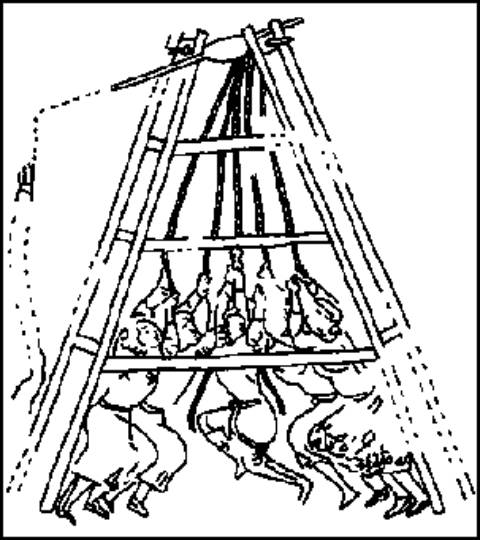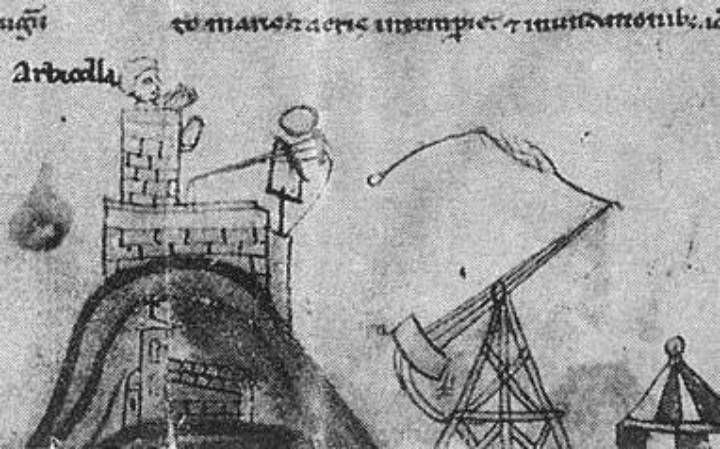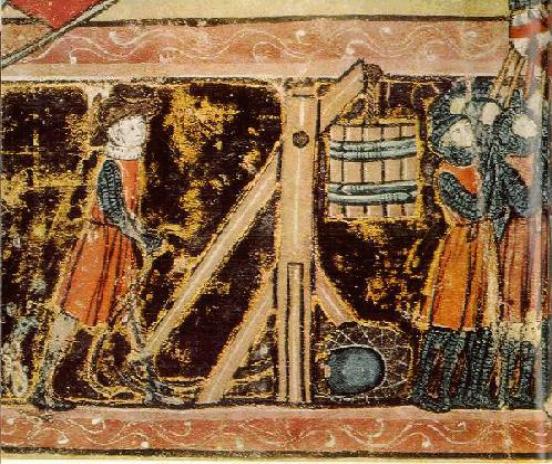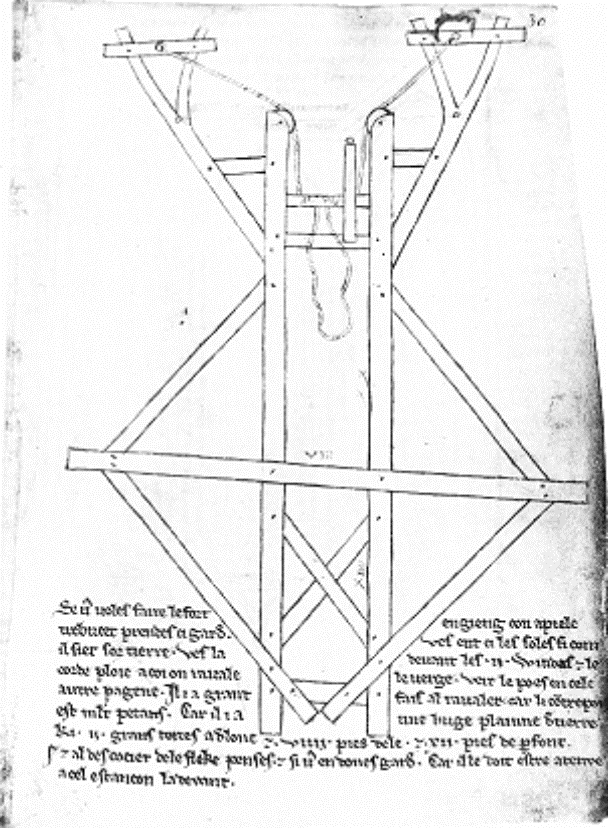
Sketch of a traction trebuchet recreated from a wall painting in the palace of Piandjikent, Transoxania. (Hermitage Museum, Leningrad) c.7th - 8th Century.
This entry is intended to advance the general populace’s knowledge of siege engines, specifically the counter ballast systems known as Trebuchet. As always, feedback is welcomed and encouraged.
Trebuchet is the French term, believed to be derived from the Latin "trabuc[h]us", for a specific piece of leverage artillery consisting of a seesaw-like lever arm with a sling affixed to it’s longer end and some form of ballast applied to its shorter. This siege engine’s origin has been traced to 4th century B.C. China. They began as what we now call traction trebuchet. A traction trebuchet is a hand-pulled machine that gains it’s potential energy from large groups of men (I have seen reference to a document calling for 600 men, though the source material was not verified) pulling on ropes rather then using attached ballast.

Sketch of a traction trebuchet recreated from a wall painting in the palace of Piandjikent, Transoxania. (Hermitage Museum, Leningrad) c.7th - 8th Century.
According to texts, the Trebuchet evolved toward a more familiar form in the 8-9th century when Arabic engineers acquired the Chinese designs (called manjaniq by the Arabs) and mounted large counterweights to them to both assist and reduce the number of men at the ropes. This transition design is sometimes referred to as a hybrid Trebuchet.Despite the textual data, as of the time of this document, I have not found graphical images to back this claim. Below is the oldest image I have access to.

Traction trebuchet on the background castle and a hybrid in the foreground. From the siege of Savonne in c.1227.
The earliest, purely gravity-powered trebuchet is denoted in the records of the siege of Castelnouvo Bocca-d’Adda Italy (c.1199), though numerous texts hint at an earlier existence. By removing the traction portion of the ballast system, not only was a more consistent and accurate throw was achieved, but much heavier projectiles could be fired at greater distances.
It is not entirely clear when these gravity-powered “engines” were picked up in Western Europe, but by the middle of the 13th century, we see evidence in writings and ordinance lists that western engineers were capable of building them in immense size. It is estimated that Villard de Honnecourt’s drawing (c.1250) of a trebuchet base would create an engine some 5 stories in height (about 50’) with a ballast capacity of 30 tons. There is documentation of earlier use, such as in Scandinavia, but we are not positive whether these were pure gravity powered or hybrid trebuchet.1
1Denmark, c.1134, Saxo's Chronicle stated when besieging Haraldsborg, king Erik Emune used a German built and operated trebuchet. In De Bello Parisiaco, Abbo de St. Germain c.890, relates an eyewitness account that this type of device was used at the siege of Paris by the Vikings in 885-86. The Annals of Saint Bertin, relates similar weapons were used at the siege of Angers in 873.
Ordinance lists and the like tell us of the construction of these engines. Generally, a heavier wood such as oak was preferred for the framing while the throwing arm was often a lighter wood, most often something in the fir family. The slings appear to be primarily leather or of woven rope net. This tabletop version is red oak with (non descript) oak dowel and a leather sling.

Unknown artist & circa, though the armor depicted implies the mid to late 14thcentury.
This image appears to show secondary fixed weight ballast in the box end of the throwing arm; however, this is only a presumption. My thought is this may be a transition weapon crossing the fixed weight and basket designs. Perhaps the engine was built just out of range and the basket had to be added as an after thought to get the projectile to its target. I do not know of any documentation expanding upon such a design.
In period, we find documents that lead us to believe that at least once, the ballast weight was transported to the erection sight from neighboring areas. Along with an order for 50 carpenters to construct a weapon “so powerful it would breach the strong walls of Stirling Castle”, Edward I demanded that lead be removed from all the churches in letters written just before the siege of Stirling (c1304). We presume this lead was used in a fixed weight engine known only as Warwolf. Because of its complexity to fabricate and expense, lead was not the most economical ballast.

Bucket trebuchet, Bibliotheque Nationale de France
The advent of baskets (AKA boxes or barrels) being mounted to trebuchet improved the operational dynamics of these weapons. The fixed weight mounting method forced the ballast to swing in an arching path, which shifted loading from vertical to horizontal along the arm’s stroke. When compared to the physics of the basket mounting, the later produced greater projectile range and more stability in the engine itself. This was accomplished by allowing the ballast to travel closer to a natural free-fall path, which gathered greater momentum and a more consistent vector of force against the weapon’s arm. The primary results were an increase in range and a more stability. This advance also allowed siege engineers and operators to rely on local terrain for ballast. Things like rocks, dirt and even water were used to power these great engines. This not only reduced the cost of manufacture, but of transportation as well. All these factors combined to make this next evolutionary step the most desirable thus far.
There are virtually no surviving “blueprints” for siege engines known in the world today, and what is known is severely lacking. Students of leverage artillery are reduced examining stacks of ordinance lists, period paintings and manuscripts to theorize how a complete engine may have looked. Details such as scale, ballast weight and range are all sketchy at best. One such area I find to be lacking is the cocking mechanism, or windlass.
The windlass is not well detailed in the artwork surrounding siege engines, let alone the use of block & tackle within such systems. We do know that pulley technology was in use as far back as ancient Rome and on sailing vessels through out history. We may; therefore, presume with a good degree of certainty that they were used on siege engines. It is a reasonable presumption, based on the comparison of the force required to raise a sail vs. that needed to cock a siege weapon, that the technology would have migrated to siege weaponry. If we refer to ‘point of interest’ #2 below, we may conclude pulley blocks and systems were so commonplace in some cultures, that they may have been completely omitted from the various forms of documentation and reference, though this is purely presumption.
The primary purpose of a windlass is to draw an engine into a cocked status. They prevent unwinding through the use of some form of ratcheting mechanism, but offer only a small mechanical advantage when readying an engine to fire. When confronted with the shear mass of the ballasts, the manpower required without the use of pulleys is staggering as is the force and strain placed on the windlass torsion members to winch the ballast into position. (Example: Using a block and tackle divides the force required to move a mass by the number of suspending ropes. The addition of two, double pulley blocks reduced the draw weight by roughly 1/4 the force originally required with a straight windlass linkage). This reduction in force comes with a cost however. The use of two, double pulley blocks multiplied the rope length required to draw the engine by 4 times and effectively cut the firing rate to 1/4 that with a straight windlass linkage.
In the late 1400's, Leonardo de Vinci depicts the use of what appears to be a set of pulley blocks as part of the windlass of a stone throwing springal. In it self, one might presume this was one of de Vinci conceptual sketches if it were not for pulley references in earlier illustrations. The 1453 edition of Valturio depicts pulley usage in a sketch of a spring engine used for launching large bolts. And while Villard de Honnecourt (c.1250) did not show a typical block and tackle system on his sketch, he did depict the use of pulleys with the roping. So we know the concept had been applied to siege engines in some fashion for quite some time. Through de Vinci, the Valturio and Honnecourt, we may be allowed to accept the use of pulleys on siege engines and make the leap to, if nothing else, the probability of their use in block and tackle arrangements.

A spring engine designed to launch two stones simultaneously. From II Codice Atlantico by Leonardo de Vinci. - Late 15th Century. Biblioteca Ambrosiana, Milan.

Trebuchet base by Villard de Honnecourt, c.1250 (Only known surviving Trebuchet "blueprint" at this time.)
The text accompanying Villiard de Honnecourt's diagram(s) is offered below. The translation is from "War in the Middle Ages" by Philippe Contamine:
"If you want to make the strong engine which is called a trebuchet, pay close attention here. Here is the base as it rests on the ground. Here in front are the two windlasses and the double rope with which one draws back the beam ("verge") as you can see on the other page. There is a great weight to pull back, for the counter-poise is very heavy, being a hopper full of earth which is two 'large toises' long and nine feet across and twelve feet deep. ("il i a une huge plainne de terre ki .II. grans toizes a de lonc et .VIIII. pies de le, et .XII. pies de parfont") Remember the arc of the arrow ("le fleke") when discharged and take great care, because it must be placed against the stanchion in front."
There is a very popular illustration of a trebuchet drawn from Honnecourt's base sketch circulating in numerous sources. This drawing shows a simple block and tackle used on a basket-style trebuchet. I refer to that of Violett-le-Duc's rendering. This work was not considered in my research as it was produced in 1854.
There are no known surviving trebuchet of the fore mentioned types known in the world today; however, according to research by Rathgen (1928), an intact trebuchet was found at Liebenmuhl, East Prussia in the 1890's. It was apparently discovered (presumably un-assembled) when an old church was being torn down. It was “immediately cut up for firewood.” The only other statement I can add to this is a personal note; I hope it saved someone from freezing to death! Since we have no authentic pieces to study, we are forced to combine archaeological tool finds, surviving paintings and manuscripts as well as architecture of the day to theorize the methods of constructing such machines.
General Fabrication:
The work before you, a helepoleis or trestle-framed trebuchet, is a conglomerate of research from numerous sources and some theory to fill in the blanks. Despite the limited reference to block and tackle in the source materials I poured through, I have chosen to include them on my trebuchet.
In keeping with the spirit of the methods used in period, the trebuchet associated with this write up was (primarily) made with muscle driven tools, the exception being the holes and pulley blocks. The tools I used are as follows:
A drill press to fashion holes | |
A Bridgeport (milling machine) to route the pockets in the pulley blocks (after 21 attempts by hand I broke down and used this machine) | |
Various hand saws | |
Various files | |
Various chisels to “square” holes for mortise and tenon joints | |
X-acto knife to cut the sling | |
A lighter to fray check the sling “ropes” | |
A mallet and chisel to shape the sling prong | |
A small bench vice | |
Sculpty & sand casting materials to make the firing mechanism |
Originally this model was designed to use golf balls as the preferred projectile; however, after re-examining all of my reference materials and notes, I have concluded this projectile was seriously over sized in relation to my Trebuchet’s ballast capacity as well as it’s scale.I have since noted that a standard rubber ball is much closer to the actual ratio of ballast weight to projectile. (Not to mention neon rubber balls are easier to see and less expensive to replace.)
There are several points of interest that I have discovered in my self-education on trebuchet. Below are a few I feel most significant or helpful to first time trebuchet design/builders.
1)The relationship between physical scale and ballast capacity are not linear!!! The ballast capacity diminishes incrementally while the physical scale remains constant. (Example: At 1/12 scale, my ballast basket can hold 14# of lead (volumetrically speaking), at 1/3 scale the basket can hold 3,697# and full scale theoretically is capable of 83,686# [though the basket itself is not strong enough physically]. So, as you can see while the size increased by 4 times from 1/12th to 1/3rd scale, the ballast weight shot up over 264 times in value. Like wise, increasing the scale 12 times, resulted in volumetric capacity increases by an amazing 5,977.6 times.) The point I am trying to illustrate is, while the popular consensus among historians is medieval trebuchet used 250-350# projectiles; your tabletop should use significantly less then the simple linearly scaled down value.
The test data I used to choose my projectile weight was based on a full-scale recreation using 3,700 of ballast and a 15# projectile. As this recreation’s arm was virtually identical to my design in axle to basket and axle to prong dimensions, I felt this was a good starting point. My calculations suggest my projectile should be .908 ounces for the 14# capacity of its ballast basket, rather than the 2-ounce golf ball I had original picked out of a combination of whim and availability.
2)When viewing period reference materials (primarily paintings and manuscripts) it is important to know the scale is usually very disproportionate. The general consensus on this seems to be, the artists of the time tended to underscore things the current society was familiar with, by minimizing it within artwork of this nature. It is also believed that some details may have been omitted for this reason. (Example: Treadmills were commonplace and the general public had experience with them at mills so it was not necessary to show them in detail or even accurately for that matter. The concept appears to be “Don’t distract the viewer from the things that are new or more important”.) Also, the clothing of the people in the depictions provide a good means to estimate the general time period of your reference materials if the date of origin is not offered where you found the illustration.
3)Sling lengths are rarely accurate as well. More times then not, they are extended, or moved, to a point where the projectile can be expounded. A perfect example of this is an image by Kolderer, believed to be illustrated in 1507. The sling is extended off the trebuchet’s base to depict the dead horse in the sling. Through my experiences (with sling lengths, not horse projectiles), I can pretty much guarantee this machine would never have thrown anything with such a long sling, in fact it is likely the horse would have caught on the trough either effectively stopping the motion or, more likely, shredding the corpse across the entire base and releasing (the sling) far to late and driving what’s left of the poor creature into the ground very near the trebuchet.

Trebuchet by Kolderer, c1507.
4)Projectile weight, prong angle and sling length are all interconnected. If you significantly change your projectile weight, you will need to change a) the sling length, b) the prong angle or c) both. This is a time consuming process that can take days to tune. Keep a good journal of everything you try!!! Physics 101 teaches us the maximum range of a projectile (in a vacuum) is achieved with a 45° launch angle. This is the point where the forward motion of the projectile and the downward force of gravity act against one another to create an optimum result in terms of range. Several siege engineers have noted 48° in their designs and text, presumably taking air friction into account. Both of these angles are theoretical when it comes to releasing a sling, so the practical thing to do is have the neighbor kid fire your engine while you stand far enough back, facing the trebuchet’s side, where you can get a good view of the arc of the projectile, then do your best to adjust your sling to release the projectile as close to a 45° path as you can.
 For non-math people, this is 45°... |
 though your projectile will follow a path similar to this when correctly adjusted . |
The three key points to remember when adjusting your trebuchet’s trajectory are:
The shorter the sling is, the earlier it will release, the higher the projectile arc will be and the shorter the range becomes.
The shallower the prong angle is, the sooner the sling will release ending with the same results as point 1).
It is generally easier to fine-tune your engine with slight modification to the prong angle then to try to shorten your sling a minute amount.
While leverage artillery has been around for hundreds of years, very few details exist to give modern day re-enactors and re-creationists a clear and concise picture of these grand weapons of warfare. It is up to us to research, and share all we can with one another in hopes that someday one of us will compile a true reference manual on the subject. I hope you have found my micro-chapter on Trebuchet inspiring and/or informative enough to set you on your way to future studies and experimentation! Until then…
Recommended Sources:
NOVA: Secrets of Lost Empires - Medieval Siege (PBS)
Modern Marvels: Siege Machines (History Channel)
The Invention of the Counterweight Trebuchet: A Study in Cultural Diffusion by Paul E. Chevedden; Dumberton Oaks Papers 54, 2000, pp.71-116
Siegecraft: Two Tenth-Century Instructional Manuals by Heron of Byzantium by Denis F. Sullivan; Dumberton Oaks Studies 36, 2000 ISBN:0-88402-270-6
Experimental Reconstruction of a Medieval Trébuchet by Dr. Peter Vemming Hansen, Nyköbing Falster; Acta Archaeologica vol. 63, 1992, pp. 189-268: http://www.middelaldercentret.dk/acta.html
Historic Counterweight Trebuchet Illustrations, Grey Co Trebuchet: http://members.iinet.net.au/~rmine/ht/htindx.html
Historic Traction Trebuchet Illustrations, Grey Co Trebuchet: http://members.iinet.net.au/~rmine/histrac.html
Medieval Siege Warfare (Elite, 28) by Christopher Gravett, Osprey Publishing
Siege Weapons of the Far East (1) Ad 612-1300 (New Vanguard, 43) by Stephen Turnbull, Osprey Publishing
Medieval Siege Weapons: Western Europe Ad 585-1385 (New Vanguard, 58) by David Nicolle, Osprey Publishing
The Manuscript of Villard de Honnecourt Folio 44 - Machines, engins, automate, Folio 45 - Engins et instrument and Folio 59 - Engin de guerre, trebuchet Bibliothèque nationale de France, Ms Fr 19093, Paris
Villard de Honnecourt and the Technical Knowledge in the XIIIth Century by Roland Bechmann*, English translation due out early 2003 by Ashgate Publishing Limited
* Special thanks to Mr. Bechmann (who has personally handled Honnecout’s trebuchet sketch(s) in his studies) for his recommendations on which of his works, with specific pages, would best suit my research goals.
Copyright Terms, Copyright Wolfram von Taus © 2002, 2003, 2004